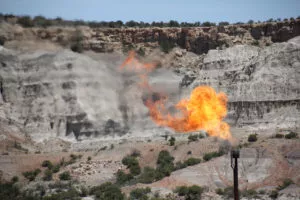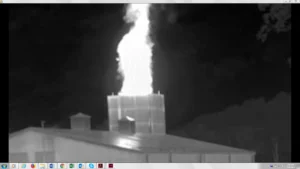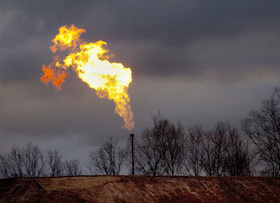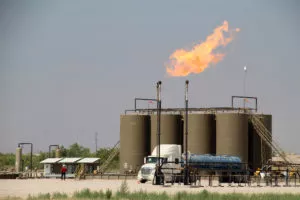A variety of air contaminants are emitted throughout the oil and gas development process, and these compounds are released from a number of sources:
- Condensate tanks
- Construction activity
- Dehydrators
- Engines
- Fugitive emissions
- Pits
- Vehicles
- Venting and Flaring
Condensate tanks
Some natural gas wells produce a semi-liquid condensate along with the gas. Condensates are hydrocarbons that are in a gaseous state within the reservoir (prior to production), but become liquid during the production process. Condensates are composed of hydrocarbons (typically those containing five or more carbon molecules), as well as aromatic hydrocarbons such as benzene, toluene, xylenes and ethylbenzene (BTEX).
Condensates may give off a characteristic hydrocarbon or petroleum-type smell. BTEX give off a sweet, aromatic odor. Most people can smell benzene when it reaches levels of approximately 1.5 – 5 parts of benzene per million parts of air (ppm). The Occupational Safety and Health Administration (OSHA) has set maximum exposure levels for workers at 1 ppm (over an 8-hour period) and 5 ppm (over a 15-minute period). At levels above 150 ppm some people may begin to experience serious and irreversible health effects.
The vapors of benzene, toluene and xylenes are heavier than air and may accumulate in low-lying areas.
Construction activity
A certain amount of construction accompanies every phase of oil and gas development (exploration, field organization, production, and site abandonment). Each requires disturbing the soil to some degree through the use of construction machinery. These activities generate particulate matter and stir up dust, which in turn react with the other prerequisites to form ground-level ozone, or smog.
Dehydrators
If the gas wells use glycol dehydrators to remove water from the gas, the dehydrator may release aromatic organic chemicals to the atmosphere. If the natural gas undergoing dehydration contains benzene, toluene, or other volatile organic compounds, significant quantities of these compounds can be released when the glycol solution undergoes regeneration.
Engines
Drilling, completion and workover trucks, rigs and equipment such as pumps typically run off of diesel-powered or gasoline engines. The exhaust fumes from gasoline and diesel fuels can produce emissions that are noticeable to people living downwind.
Polycyclic aromatic hydrocarbons (PAHs) are found in exhaust from motor vehicles and other gasoline and diesel engines. A long list of other air pollutants, including nitrogen oxides, carbon monoxide, BTEX, formaldehyde and metals are also contained in diesel fuel combustion products.
Fugitive Emissions
Fugitive emissions are unintentional leaks of gases. This may occur from breaks or small cracks in seals, tubing, valves or pipelines, as well when lids or caps on equipment or tanks have not been properly closed or tightened. When natural gas escapes via fugitive emissions, methane as well as volatile organic compounds (VOCs) and any other contaminants in the gas (e.g., hydrogen sulfide) are released to the atmosphere.
Recently, while on a tour of oil and gas fields in Weld and Adams counties, a team of high-tech Environmental Protection Agency investigators used an infrared camera to look for fugitive emissions, which are normally invisible to the naked eye. They aimed their camera at pipelines, valves and hatches atop storage tanks, the EPA regulators found numerous sources of fugitive emissions.
This video reveals fugitive emissions from a Barnett Shale gas well site.
Dr. Theo Colburn of The Endocrine Disruption Exchange, explained:
The tanks you see in this picture can be found across the gas fields in the US.
They look harmless as you drive by just like the other stationary equipment you see on well pads. Without an infrared camera, as in this case, that picks up the plume of the highly active volatile chemicals escaping from the tanks, no one would suspect that the tanks could possibly pose a public health problem.
As natural gas extraction continues to increase, federal, state, and local public health authorities and regulatory agencies are unprepared to deal with the problem.
Pits
Earthen pits are often used to store or evaporate produced water and waste water from natural gas dehydration or oil/gas separation units. Additionally, prior to disposal drilling wastes (muds and cements) and fracking wastes are often stored in earthen or metal pits that are open to the air. There are hundreds of different chemicals that may be used during drilling, fracking and workover procedures, including acids, biocides, surfactants, solvents, lubricants and others.
Chemical compounds that are naturally present in natural gas, or chemicals that have been injected downhole during drilling, hydraulic fracturing or well workover operations, will be present in the water or wastes that are held in pits. Some of the lighter or more volatile chemicals and compounds, such as benzene, toluene, hydrogen sulfide, etc., will escape from the produced water pits into the atmosphere. These chemicals may then be transported through the air, into nearby neighborhoods. The odors associated with the natural gases or chemicals will vary, depending on the concentrations, volumes, and combinations of chemicals released. Also see: Alternatives to Pits.
Vehicles
The biggest pollutant from motor vehicle traffic at oil and gas operations is dust. Fracking a single well requires 1,400 truck trips.
Burning fuel to power trucks also emits NOx, carbon monoxide, and sulfur dioxide, as well as particulate matter. These compounds combine with VOCs to form ground-level ozone (smog).





